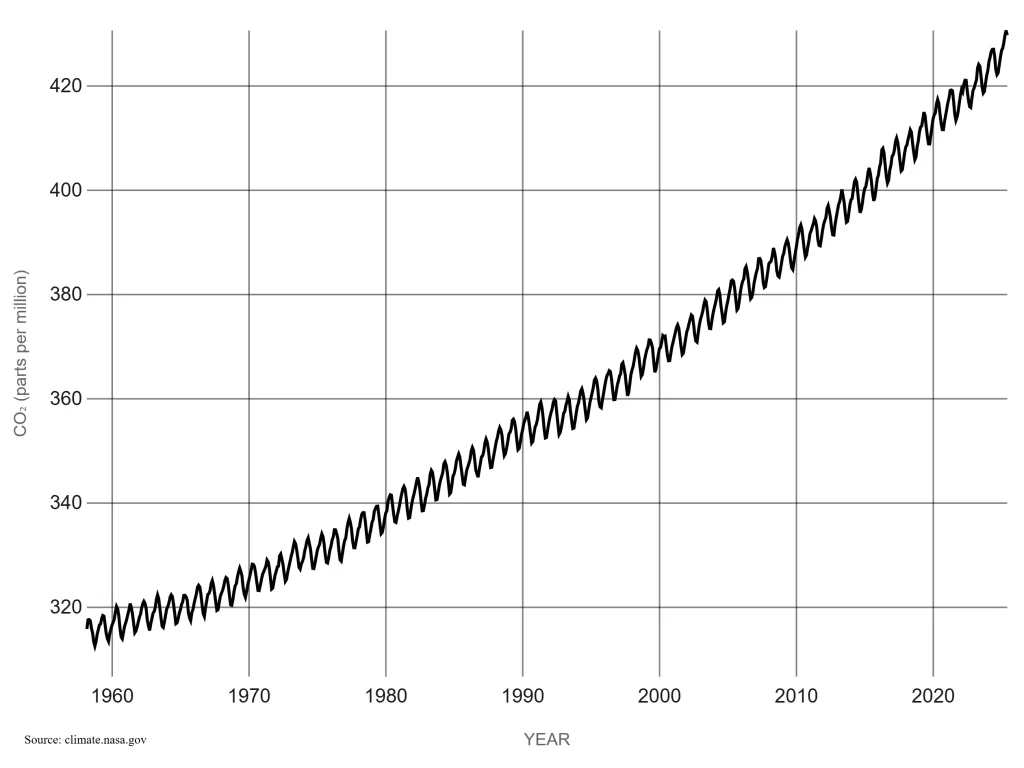What are CO2 emissions and why do they matter
Carbon dioxide (CO2) is a trace gas present in Earth’s atmosphere and one of the main greenhouse gases (GHGs) (NASA, 2025). Through absorbing and re-emitting infrared radiation, GHGs help to maintain our planet’s temperature within habitable limits. Keeping CO2 levels within natural limits (the levels of CO2 without human interference) is important for the THRIVE Foundational Focus Factor (FFF) of Strong Sustainability, the ability of nature to self-regulate and regenerate for future generations. There are three GHGs present in our atmosphere: carbon dioxide (CO2), methane (CH4), and nitrous oxide (N2O).
Naturally, volcanoes and bushfires generate carbon dioxide; however, human activities increasingly generate emissions, contributing to the phenomenon of climate change. The Mauna Loa Research Station in Hawaii measures the levels of carbon dioxide in the atmosphere, as shown below (NOAA, 2025). Measuring the levels of carbon in the atmosphere is one of the main determinants of climate change for decades, used as a proxy for environmental health.

Source: NASA, 2025
From these observations, it is evident that CO2 levels have been steadily increasing for decades and have been on a sharp upward trend since the 1960s. While CO2 levels do fluctuate naturally, current increases are greater than natural variations. In fact, climate change would not naturally occur for another 10,000 years. This acceleration creates follow-on effects on other parts of the environment. Plants that flower in response to changing seasons are flowering earlier than normal, disrupting the timing between flowering activity and pollinator activity.
Global overview of carbon emission trends
CO2 increases are a direct result of the use of fossil fuels. Oil, gas, and coal from reserves deep underground release large amounts of greenhouse gases when burned. Fossil fuels, particularly coal, have been one of the primary sources of electricity generation since the late 1800s. Fossil fuels have permeated every corner of our lives, from powering our houses to fuel production and even to sports, especially those involving vehicles.
Globally, carbon dioxide levels have been increasing for centuries, culminating in the climate crisis we now face. This means that the planet is warming far faster than it would without human interference, altering climate trends and ecological processes, and harming biodiversity. As the increase directly results in warmer temperatures, methods to alleviate heat, such as air conditioners, become more frequently used, further increasing the amount of fossil fuel burned to produce electricity, thereby increasing emissions.
Countries with the highest total CO2 emissions
Many countries are responsible for this increase in emissions; however, some countries are larger contributors than others. Countries such as Bhutan claim to currently absorb more emissions than they emit, making them carbon negative (World Expeditions, 2025). However, some countries continue to invest in fossil fuels despite the overwhelming evidence of their impact on the planet. China, the US, and India are the biggest emitters in 2023. The European Union as a whole comes in fourth, and does not emit as much as each of these countries individually, as seen in the figure below. The small countries affected the most by climate change, such as island nations in the Pacific, are those doing the most to reduce their emissions, despite being the lowest emitters.

Source: Ritchie et al., 2023
It must be noted that despite China’s volume of emissions, it is leading the way to a renewable future by cutting its emissions by ~1% every year. This is with a 1.6% reduction in the first quarter of 2025 alone (Myllyvirta, 2025). They are now the leaders in rooftop solar, have electrified their entire urban public transport fleet, and actively promote renewable activity. While 1% doesn’t seem significant, the reduction is critical when factoring in the volume of emissions being cut and the rising electricity demand. This is the first time in China’s history that demand for renewable energy has outweighed the demand for fossil fuel-powered electricity. The speed of their transition is unmatched globally (World Economic Forum, 2025). Within a few years, China could also become one of the lowest emitters with further cuts to emissions in its targets.
Across the planet, countries are using a variety of methods to cut their emissions. These methods include transitioning to renewable energy, improving energy efficiency, and policies to reduce emissions, such as net zero targets. Emssions reduction levels vary between countries with some lagging behind global expectations set by climate experts. There is currently global momentum to drastically cut emissions and meet global climate goals. More than 110 countries have set net zero by 2050 targets, indicating a strategy of limiting climate change to 2oC above pre-industrial levels (Fominova, 2022).
Comparing emissions per capita across nations
Comparing emissions across nations is not simple. There is no single standard metric for comparing national CO2 emissions across the planet (Ritchie et al., 2023). However, emissions comparisons should ideally include a per capita basis, which currently is not consistently done. This means they take into account the amount of emissions per person within a country. Countries with very low populations can become large emitters if the emissions per person are very high, even if the total emissions are actually a low number.
On the other hand, a densely populated country can have very low emissions per person while also having a large total emission level. Small island nations such as Palau and Qatar are examples of this (Ritchie et al., 2023). Per capita emissions are important in determining the largest contributors to high carbon levels. The following figures show how while Australia has relatively low overall emissions, per capita emissions are relatively high. Despite Australia’s emissions totalling only 1% of total global emissions, Australia emits more than both the US and China per capita as well as more than China and the EU combined.

Source: Ritchie et al., 2023
The Intergovernmental Panel on Climate Change (IPCC) has guidelines for determining emissions and comparing countries. These include key broad categories of emission types (IPCC, 2006). National emissions can also be broken down and categorised as:
- Land-Use Change
- Industry
- Agriculture
- Transport
- Waste
These categories have multiple subcategories, providing insight into where emissions originate. Following emissions reporting in these categories, each nation must undertake stringent quality checks. Comparisons between nations are then possible without using complex algorithms.
Key factors influencing national emission levels
There are many factors that influence the emissions of a nation. These include, but are not limited to:
- Economic Growth
- Affluence
- Population Size and Urbanisation
- Energy Consumption and Structure
- Technological Advancement
- Industrial Activity
- Energy Regulation Policies
- Environmental Conditions
Emissions and income levels have become tightly coupled in recent years. Unsurprisingly, lower-income countries are more reliant on fossil fuels as they are often cheaper and more readily accessible. They are also more likely to be densely populated, increasing emissions and the demand for energy. This pressures governments into supplying people with whatever fuel they can, regardless of the effects of that energy in the form of pollution.
The Industrial Revolution in England (1750-1900) saw great technological advances and an astounding number of new inventions. However, these advances used coal as fuel, creating such high levels of pollution that a new term resulted, smog, a combination of smoke and fog. Smog levels were so bad that it was often difficult to see the sky, clothes were stained black, and people frequently suffered and died from respiratory illnesses. This was the start of the era of coal, which has continued to this day (Anderson, 2024).
Policies were introduced to limit the amount of emissions factories could emit, with fines for exceeding the limits. This had limited efficacy at the time but has now become standard in developed countries worldwide.
Insights for global climate policy and action
The unchecked impact on the environment set by the Industrial Revolution continues today despite the current knowledge of the impact of fossil fuels, particularly coal. Coal mines continue to be approved, despite public protests and petitions (ABC, 2025). Most developed countries are facing backlash over the continued use of fossil fuels and the perception that governments are not transitioning to renewable energies fast enough.
Governments must set stronger emissions targets to below the levels of the 1990s, when the IPCC released its first report. These targets must include a variety of sectors, including health, equality, and infrastructure. Assistance to developing countries for transitioning away from coal should also become a priority for wealthier countries. Governments must also assign more finances to climate change mitigation, reducing emissions and increasing the number of renewable projects across the country.
Science-Based Targets, a THRIVE FFF, allow emission reduction targets based on specific research. They are useful in identifying the best path forward to ensure that emissions continue to reduce. Science-Based Targets are important for understanding best practice, the most sustainable way forward, and the consequences should nations choose not to decarbonise.
The G20, a coalition for international economic cooperation, is responsible for coordinating efforts on global challenges between each of its twenty member states. Currently there are nineteen countries included, as well as the European Union and the African Union (Australian Government, 2025). Little action has occurred on climate change within the G20, despite creating 75% of global emissions.
Conclusion and Call to Action
CO2 levels have been rising for decades, and this rise must halt for the good of the planet. Individuals must pressure elected leaders into prioritising funding for emissions reductions, increasing the scale of renewable projects, and reducing funding for fossil fuel plants and mines. Immediate emission reductions are essential for mitigating future impacts of climate change and creating a thriving future.
Nations must decarbonise by reducing their per capita emissions as well as total emissions to below 1990 levels. Identifying the key categories of carbon emissions and creating strategies to lower levels should be prioritised by governments worldwide.
Achieving THRIVE goals
THRIVE, The Holistic Regenerative Innovative Values Entity, is a not-for-profit environmental organisation that focuses on raising awareness and delivering solutions to many of the world’s problems. Achieving this through pillars of thrivability, known as the THRIVE Framework. The THRIVE Framework includes twelve Foundational Focus Factors (FFFs). Strong Sustainability, the ability of the environment to regenerate, is vital for mitigating climate change. An example of Strong Sustainability is the protection of the planet through the reduction in emissions to levels indicated by research studies. Put simply, Science-Based Targets are quantifiable targets based on these studies. Emissions targets are an example of Science-Based Targets as they ensure efficacy. Science dictates the level to which emissions need to be reduced in order to gurantee the health of the planet.
A Thrivable Framework
THRIVE aims to extend thinking and research beyond sustainability, into thrivability, the state where both humans and nature live harmoniously without compromising the other. To find ways to help, head to the THRIVE website. Here, there are a variety of presentations, whitepapers, and articles that cover an array of topics. Head to the YouTube channel to watch inspiring videos or podcasts. Subscribe to the newsletter to keep up to date on the news at THRIVE and register for the workshops. Be sure to attend the monthly webinar and volunteer with THRIVE.
Why trust us?
At THRIVE Project, we’re all about facts that matter—and a future that flourishes. Our team of researchers, writers, and thrivability experts dig deep into the science so you don’t have to. Everything we publish is based on credible sources, double-checked for accuracy, and written with one goal in mind: helping you make sense of the world and how to improve it. We’re independent, non-profit, and here to spark real change with knowledge you can count on. Find out more about our team.
– THRIVE Project























